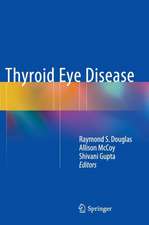Myopia and Glaucoma
Editat de Kazuhisa Sugiyama, Nagahisa Yoshimuraen Limba Engleză Hardback – 3 noi 2015
The relation between myopia and glaucoma has been the subject of many clinical trials and population-based studies. Most of the data has suggested that moderate to high myopia is associated with increased risk of primary open-angle glaucoma, normal tension glaucoma, and ocular hypertension. There are several factors involved in the diagnosis of glaucoma, but it is often difficult to determine the presence of glaucoma in myopic eyes.
A myopic eye, especially in cases of moderate to high myopia, tends to have a thin retina and choroid and to appear thinner than normal. Even with new imaging technologies with improved sensitivity and specificity for detecting glaucoma, each technology presents some challenges when assessing myopic eyes.
This book furnishes an overview of these diagnostic challenges with reference to the growing prevalence and severity of myopia in various parts of the world, providing many valuable hands-on reports and clinical studies by authoritative authors. This knowledge will help to do away with the vague area between high myopia and glaucoma faced by clinicians.
| Toate formatele și edițiile | Preț | Express |
|---|---|---|
| Paperback (1) | 517.14 lei 6-8 săpt. | |
| Springer – 23 aug 2016 | 517.14 lei 6-8 săpt. | |
| Hardback (1) | 647.01 lei 38-44 zile | |
| Springer – 3 noi 2015 | 647.01 lei 38-44 zile |
Preț: 647.01 lei
Preț vechi: 681.06 lei
-5% Nou
Puncte Express: 971
Preț estimativ în valută:
123.80€ • 129.61$ • 102.44£
123.80€ • 129.61$ • 102.44£
Carte tipărită la comandă
Livrare economică 01-07 aprilie
Preluare comenzi: 021 569.72.76
Specificații
ISBN-13: 9784431556718
ISBN-10: 4431556710
Pagini: 113
Ilustrații: VII, 113 p.
Dimensiuni: 155 x 235 x 15 mm
Greutate: 0.39 kg
Ediția:1st ed. 2015
Editura: Springer
Colecția Springer
Locul publicării:Tokyo, Japan
ISBN-10: 4431556710
Pagini: 113
Ilustrații: VII, 113 p.
Dimensiuni: 155 x 235 x 15 mm
Greutate: 0.39 kg
Ediția:1st ed. 2015
Editura: Springer
Colecția Springer
Locul publicării:Tokyo, Japan
Public țintă
Professional/practitionerCuprins
1. An epidemiologic perspective.- 2. Clinical features in Myopic Glaucoma.- 3. Glaucoma diagnosis in myopic eyes.- 4. High Myopia and Myopic Glaucoma: Findings in the Peripapillary Retina and Choroid in Highly Myopic Eyes.- 5. Visual Field Damage in Myopic Glaucoma.- 6. Myopic Optic Neuropathy.- 7. High Myopia and Myopic Glaucoma: Anterior Segment Features.- 8. Ocular Blood Flow in Myopic Glaucoma.
Textul de pe ultima copertă
This book serves as an introductory reference on clinical aspects of glaucoma and myopia, providing essential guidelines for diagnosis and monitoring of glaucoma progression in patients, especially those with high myopias. Many clinical studies are presented by leading experts in the field in an accessible style, making the content suitable not only for ophthalmologists but also for optometrists and certified orthoptists as well as for students.
The relation between myopia and glaucoma has been the subject of many clinical trials and population-based studies. Most of the data has suggested that moderate to high myopia is associated with increased risk of primary open-angle glaucoma, normal tension glaucoma, and ocular hypertension. There are several factors involved in the diagnosis of glaucoma, but it is often difficult to determine the presence of glaucoma in myopic eyes.
A myopic eye, especially in cases of moderate to high myopia, tends to have a thin retina and choroid and to appear thinner than normal. Even with new imaging technologies with improved sensitivity and specificity for detecting glaucoma, each technology presents some challenges when assessing myopic eyes.
This book furnishes an overview of these diagnostic challenges with reference to the growing prevalence and severity of myopia in various parts of the world, providing many valuable hands-on reports and clinical studies by authoritative authors. This knowledge will help to do away with the vague area between high myopia and glaucoma faced by clinicians.
The relation between myopia and glaucoma has been the subject of many clinical trials and population-based studies. Most of the data has suggested that moderate to high myopia is associated with increased risk of primary open-angle glaucoma, normal tension glaucoma, and ocular hypertension. There are several factors involved in the diagnosis of glaucoma, but it is often difficult to determine the presence of glaucoma in myopic eyes.
A myopic eye, especially in cases of moderate to high myopia, tends to have a thin retina and choroid and to appear thinner than normal. Even with new imaging technologies with improved sensitivity and specificity for detecting glaucoma, each technology presents some challenges when assessing myopic eyes.
This book furnishes an overview of these diagnostic challenges with reference to the growing prevalence and severity of myopia in various parts of the world, providing many valuable hands-on reports and clinical studies by authoritative authors. This knowledge will help to do away with the vague area between high myopia and glaucoma faced by clinicians.
Caracteristici
Comprehensive review of research on myopic glaucoma Includes many clinical studies that help readers better understand myopia and glaucoma Beneficial not only to ophthalmologists at teaching centers, universities, clinics and hospitals but also to subspecialty students and postgraduate students









